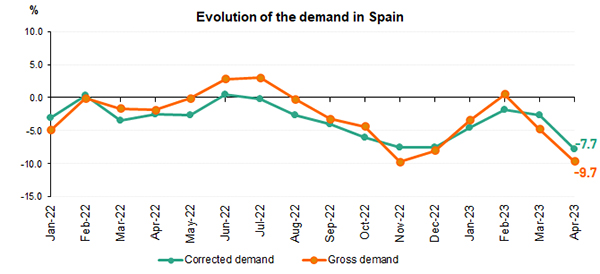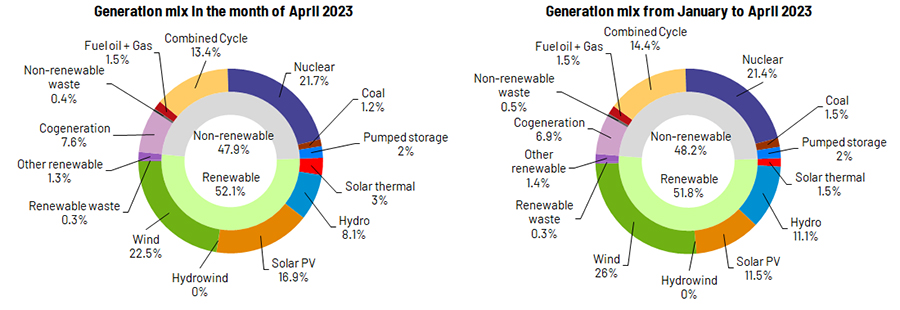For 40 years, we've been driving our country's economic and social progress. Four decades shaping Spain.
Demand for electricity in Spain fell 7.7% in April
- Renewables generated 52.1% of the country's electricity this month and 75.4% of the energy mix was obtained using zero-carbon energy technologies
- Solar photovoltaic production is 38% higher than in the same month of 2022 and wind power continues to lead the national generation mix for the sixth consecutive month.
National electricity demand in March experienced a 7.7% decrease year-on-year after having factored in the influence of seasonal and working patterns. In gross terms, demand is estimated at 17,678 GWh, down 9.7% on April 2022.

In the first four months of 2023, Spain recorded a cumulative demand of 80,330 GWh, 4.3% less than in the same period of 2022. Once again, after having factored in the influence of seasonal and working patterns, demand fell by 4.2% compared to 2022
During April, renewable energy production reached 10,967 GWh, 52.1% of the total generation mix and 0.3% higher than in April 2022. For its part, electricity production obtained using zero-carbon energy technologies accounted for 75.4% of the total.
For the sixth consecutive month, according to provisional data available at the time of this press release, wind was the leading energy source with a production of 4,728 GWh and a share of 22.5% of the total mix.
For its part, solar photovoltaic generated 3,563 GWh in April, up 38% year-on-year, reaching a monthly generation peak that is 5.4% higher than the previous one recorded in July 2022 and accounted for a share of 16.9% in the national generation mix.
Hydro, whose share in April was down 4.6% year-on-year, generated 1,699 GWh, accounting for 8.1% of the total.

Demand for electricity in the peninsular system falls by 8.2%
Regarding the mainland system, and after having factored in the influence of seasonal and working patterns, demand for electrical energy was 8.2% lower than in April 2022. In gross terms, demand was 16,548 GWh, down 10.2% year-on-year.
In the first four months of the year, electricity demand on the Spanish mainland stood at 75,732 GWh, down 4.5% on the figure recorded in 2022. After having factored in the influence of seasonal and working patterns, demand fell by 4.4%.
According to provisional data available at the time of this press release, the renewable power generation fleet on the Spanish mainland as a whole accounted for nearly 53.9% of the total mix in April, registering a production of 10,778 GWh, up 0.2% year-on-year. Production obtained using zero-carbon energy technologies accounted for 78.4% of the total mix.
The energy generation mix on the mainland in April was also led by wind power, which accounted for 23.1% of the total, with a total production of 4,620 GWh during the month.
The electricity system in the Balearic Islands and the Canary Islands
Electricity demand in the Balearic Islands in April, after having factored in the influence of seasonal and working patterns, was 2.8% lower than in the same month in 2022. Thus, gross demand is estimated at 411,126 MWh, down 5.8% year-on-year. In the first four months of 2023, gross demand in the Balearic Islands is estimated at 1,705,251 MWh, 2% less than in the same period of 2022.
In terms of generation, combined cycle, with a share of 69.1% of the energy produced in the Balearic Islands, was the leading energy source in the islands in April. For its part, renewable energy obtained using zero-carbon energy technologies in the Balearic Islands was 63.4% higher than in April 2022 and accounted for 16% of the total, with solar photovoltaic being the main source of renewable energy and ranking second in the overall generation mix of the islands, with a share of 12.5% of the total mix. In addition, this month, the subsea link between the mainland and Majorca contributed to covering 23.8% of the electricity demand in the Balearic Islands.
For its part, and after having factored in the influence of seasonal and working patterns, electricity demand in the Canary Islands grew by 2% year-on-year. In gross terms, demand was 690,373 MWh, up 2.5%. In the first four months of 2023, demand in the Canary Islands is estimated at 2,769,860 MWh, up 0.8% compared to the same period in 2022.
In terms of electricity generation in the Canary Islands, combined cycle, with 42.2% of the total, was also the leading technology in April. Renewables and generation obtained using zero-carbon energy technologies produced 20.1% of the total generation this month, with wind being the second technology in the generation mix, with a share of 15.5%.
Consult our Daily Balance Report for more information on the National, Peninsular, Balearic Islands and Canary Islands electricity systems as at the close of April.
Downloads












